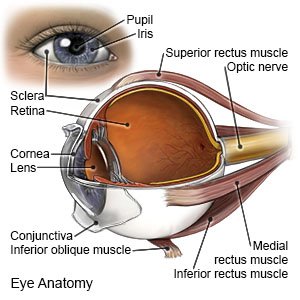Eyelid Swelling
Medically reviewed by Drugs.com. Last updated on Aug 4, 2025.
What do I need to know about eyelid swelling?
Eyelid swelling can occur in 1 or both eyes. The upper eyelid, lower eyelid, or both can become swollen. This depends on the cause.
 |
What are common causes of eyelid swelling?
- An allergic reaction
- Trauma to the eye area
- An infection on or near the eye
- An insect bite
- A foreign body in the eye
- Certain medical conditions or autoimmune disorders
What are the signs and symptoms of eyelid swelling?
Your symptoms will depend on the cause of the swelling. Your eyelid may be so swollen you cannot open your eye. Your eyelid may be red, itchy, painful, or warm to the touch. You may have a rash or blisters on your eyelid.
How is the cause of eyelid swelling diagnosed?
Your healthcare provider will examine your eye. Tell your provider about any recent injury to your eye. Tell your provider about all your current medicines and any allergies or medical conditions you have. You may need any of the following:
- Blood tests may show an infection.
- A CT or MRI pictures may show a foreign body or another condition causing your symptoms. You may be given contrast liquid to help the eye show up better in the pictures. Tell the healthcare provider if you have ever had an allergic reaction to contrast liquid. The MRI machine uses a powerful magnet. Do not enter the MRI room with anything metal. Metal can cause serious injury from the magnet. Tell the healthcare provider if you have any metal in or on your body.
How is eyelid swelling treated?
Treatment depends on the cause of the swelling. You may need any of the following:
- Medicines can help decrease pain, swelling, or itching. You may need medicine to treat an infection.
- Surgery may be needed to remove a mass, cyst, or foreign body if other treatments do not work.
How can I manage my symptoms?
- Apply a warm compress to your eyelid as directed. Use a soft washcloth soaked in warm water. Leave the compress on your eyelid for 5 to 10 minutes. Do this up to 5 times a day, or as directed.
- Wash your hands before and after touching your eye area. Use soap and water. Do not allow medicine containers to touch your eye when you are applying medicine to the area. Examples include eye drops or ointments.

- Care for your eye area as directed. Carefully wash the eyelid with a gentle soap and water. Your provider may recommend using baby soap to clean the area.
When should I seek immediate care?
- You have a sudden change in vision or vision loss.
- You have pain when you move your eye.
When should I call my doctor?
- Your symptoms do not get better even after treatment.
- You have questions or concerns about your condition or care.
Care Agreement
You have the right to help plan your care. Learn about your health condition and how it may be treated. Discuss treatment options with your healthcare providers to decide what care you want to receive. You always have the right to refuse treatment. The above information is an educational aid only. It is not intended as medical advice for individual conditions or treatments. Talk to your doctor, nurse or pharmacist before following any medical regimen to see if it is safe and effective for you.© Copyright Merative 2025 Information is for End User's use only and may not be sold, redistributed or otherwise used for commercial purposes.
Further information
Always consult your healthcare provider to ensure the information displayed on this page applies to your personal circumstances.
